There is are two vastly superior cymbal stamp timeline for A Zildjian Cymbals here and here.
The below record is fragmented and incomplete by comparison.
First Stamp (1929-1939)
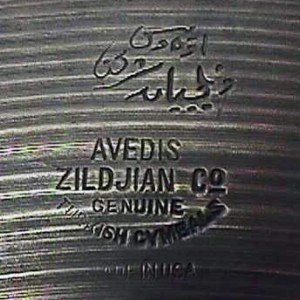 |
This is the “first stamp” used for cymbals produced by Avedis Zildjian in the United States, starting in 1929. The Arabic has a very specific look, appearing somewhat wide in the lettering. In later stamps the Arabic appears thinner. The A stamps use a stylized way of writing Avedis (” وه ـض سا “) across the top with the letters sort of piled on top of each other. Also Zildjian (” زــلجـيان “) below has the /l/ (“ل “) is sort of packed on top of the [dʒ] (” جـ “) in the stamp. |
|
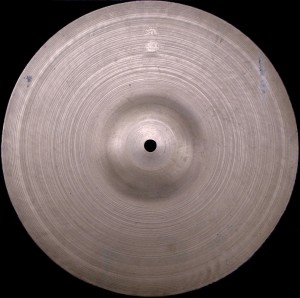 |
The first A Zildjian cymbals tend to be very small (8″ to 12″) and paper thin. This one to the left was just over 11″. Though they mainly produced splash cymbals, a few china-type early zildjians are known to exist. | |
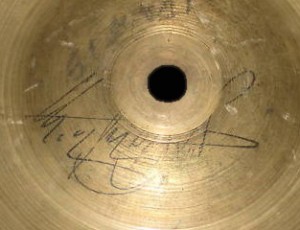 |
Another giveaway is the signature under the bell. The first stamp is the only one to include the cymbalsmith’s signature under the bell. Personally, I think it is a stylized writing of “Avedis Zildjian” given the caveats that the writing system was a mess for Turkey at this time. Family members in Istanbul were changing their name to “Zilcan” and Turkey only started to use an adopted version of the Latin alphabet in 1928. |
Middle First Stamp (Mid 1930s?)
 |
I am positing a middle era early stamp with less robust stamping in the Arabic letters. The telltale feature—the angular shape of the letter “J” in “ZILDJIAN”—is more pronounced in the middle era stamps. Here is an animated comparison of the two first stamps. Here are a few other photos of the stamp: 1 | 2 |
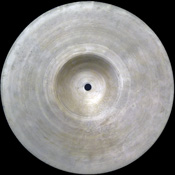 |
This is a paper-thin 10″ with the middle first stamp. This cymbal has a larger bell than the one above. The signature was scrubbed off at some point. |
 |
This stamp shows how different stamping action could create more robust stamps, but the push the metal around. (cleaner version). The middle-early stamp has a different ں toward the lower left in the Arabic. It is more hooked than in other first stamps. However some stamps seem to mix early and middle early characters (see another example). A commenter (below) sayd that the “US” was added by the military. |
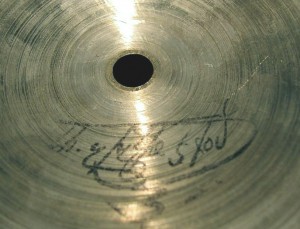 |
Here’s another mystery: first the signature sort of changes style. This one from a 15″ with the “middle first stamp”… |
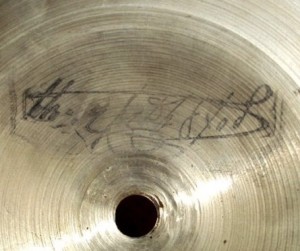 |
…then there are examples of this rubber-stamped “signature” on several that I’ve seen. You can tell it is rubber-stamped because there is a rectangular shape stamped around the signature in the same ink. Also, with respect to the bell hole, this would be an upside down version of the on above. Or, “signed” from a different angle, depending on how you prefer to think about it. Usually, bell signatures are below the hole, as though the hole were a little halo above the signature. |

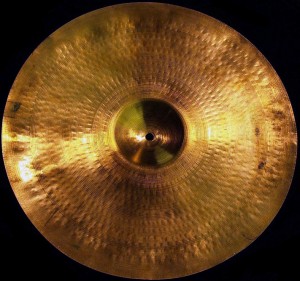
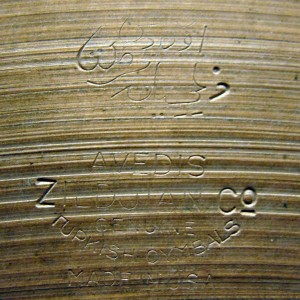
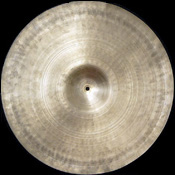
Thanks for doing this series of stamps. Long overdue.
The US in the [Middle First Stamp] photo probably indicates it was bought and owned by the US military. Similar stampings appear on drums and silverware that they bought (probably other stuff too). In this case it wasn’t stamped by Zildjian, but by the military when they received it.
Where did you get all this information?
That seems like a fair question, Stu. I should post a “methodology” section on this website at some point. Briefly, I have university access to library resources on cymbal history, I’ve found much information circulated around the internet in various languages, and have done some work to resolve translation issues and apply logic to create sequences. Many of the various facts found on this website will be attributed to the people who contribute them. For instance, my friend Carol has just supplied several translations for the China cymbals, so she is cited in the intro to that page.
If you can help add or correct the information on this website, I will give you credit for the changes.
Hey Rob,
Congratulations and thanks for the excellent work on the complicated subject of cymbal stamps and identification.
Do you think an algorithmic approach to cymbal ID would work? ie an if/than approach?
Or do you think the variables are too many to make that system useful?
HAVE A SET OF 13″ HATS ONE IS FROM MID TO LATE 30S THE OTHER IS A TRANSTAMP BUT THE LETTERS OR A BIT WIDE AND HOLLOW.
ARE THESES THE FIRST ONES THAT WERE MADE PRE WAR? THANKS
Rocky, the hollow letter stamp is probably from the 1950s. There are some other timelines out there. This one places the hollow letter A Zildjian stamp at 1955-1963. http://www.hidehitters.com/cymbals/Zildjianstamps/timeline.html#BIGSTAMP
AND THE OTHER LETTERS LOOK LIKE THE MID 50S KIND?
MAYBE THE LAST ONES INTO THE MID 50S?
I TRIED MY BEST WITH THE PHOTOS. YOU CANT TELL MUCH HERE BUT THE MIDDLE LETTERS ARE A BIT WIDER LOOKING .
THE OUTLINE OF THEM ARE CUT DEEPER THAN ALL OTHERS I,VE SEEN,HENCE THEY HAVE KIND OF A HOLLOW LOOK TO THEM.
Dave, it looks like an Italian cymbal from around the 1940s. The hammering pattern is very distinctive to those cymbals. Many cymbals from that time were simply stamped “Made in Italy” and it is quite likely that the ink stamp was cleaned off or worn off by the time you got it.
There is an extended discussion of the Ajaha issue in the comment section to the Italian (UFIP) cymbals page.
This might also interest you: http://en.wikipedia.org/wiki/Cymbal_manufacturers#AJAHA_Cymbals
I have a Zildjian cymbal with a stamp that says:
CONSTANTINOPLE
Made in USA
but there is no Ink logos or anything, I am wondering what you make of this. Could the Ink have been washed off? The cymbal looks brand new, it must have been polished. I will try to get a picture soon. The hammering and lathing look like that of a K, so maybe I just cant make out the K.
I’m confused by this cymbal. Does a stamp like the one above exist, if the A is actually a K?
There were several “A Zildjian & Cie Constantinople” cymbals made during the 1970s.
It was a gimmick to sell more cymbals.
But they only changed the logo.
They look like machined cymbals, not hand made.
It is also a machined cymbal.
Hi guys. What do you think about this Stamp? I Think it is one of these 1930s.
Look here for photos.
Hi Sven. Look at comment #1 above. The “U.S.” stamp comes from the United States military.
For anyone curious about the “U.S.” stamping on cymbals, yes, it was ANY equipment contracted/ procured by the U.S. Army (and as the air force in WW2 was a part of the Army it applied to that branch as well. The U.S. Navy had its own style stamp -anchor usually but often used Army instruments as well) whether it was bugles, cymbals or ammo cans. ALL were stamped and, in many cases with actual military equipment, dated as well. These cymbals would be dated (roughly) 1942 until the mid 50’s (post Korea) and many have found their way into ‘private’ hands.
I have just purchased a 20″rock ride from ebay uk.this cymbal has no stamp at all.the ink logo at the bottom just says zildjian.it looks and sounds like an avedis.judging by the amount of dirt I cleaned from it,it could be 70s/80s.was there a period when zildjian never stamped there cymbals.
regards
gerry
Are you aware of my new Avedis site?
http://black.net.nz/avedis.html
I’d like you to considered linking to it instead of the old Hidehitters site.
Steve Black (Zenstat, Cymbalholics Moderator)
I added a link to the first line of this page but why remove the Hidehitter’s link? The more info the merrier, no?
THE SIGNITURE UNDER THE OLD BELLS ARE NOT IN TURKISH, THATS IN THE ARMENIAN LETERS AND IT READS A. ZILDJIAN IN ARMENIAN LETTERS… SINCE ZILDJIAN IS AN ARMENIAN NAME AND AVEDIS IS TOO…
THE FAMILY WAS ARMENIAN AND LIVED IN TURKEY
Hi, I recently found your page and love the information. Thanks for posting it. I wanted to pass along a few pics of my A Zildjian splash which I believe is a first stamp from the 30s. I wasn’t able to add the pictures in this comment section but here is a link to the photos. http://bensdrumcollection.blogspot.com/2014/08/1930s-12-avedis-zildjian-splash-cymbal.html Thanks for the great site!